www.scielo.br/cam
Fractal coding based on image local fractal dimension
AURA CONCI and FELIPE R. AQUINO
IC – Computer Institute, Department of Computer Science
UFF – Federal Fluminense University, r. Passo da Patria 156, 24210-240 Niteroi, RJ, Brazil E-mails: aconci@ic.uff.br / felipe@lps.ufrj.br
Abstract. Fractal codification of images is based on self-similar and self-affine sets. The
codification process consists of construction of an operator which will represent the image to be
encoded. If a complicated picture can be represented by an operator then it will be transmitted
or stored very efficiently. Clearly, this has many applications on data compression. The great
disadvantage of the automatic form of fractal compression is its encoding time. Most of the time
spent in construction of such operator is due on finding the best match between parts of the image
to be encoded. However, since the conception of automatic fractal image compression, researches
on improvement of the compression time are widespread. This work aims to provide a new idea for
decrease the encoding time: a classification of image parts based on their local fractal dimension.
The idea is implemented on two steps. First, a preprocessing analysis of the image identify the
complexity of each image block computing its dimension. Then, only parts within the same range
of complexity are used for testing the better self-affine pairs, reducing the compression time. The
performance of this proposition, is compared with others fractal image compression methods. The
points considered are image fidelity, encoding time and amount of compression on the image file.
Mathematical subject classification: Primary: 68P30; Secondary: 94A08, 68U10,
68U05, 68P20, 65D15.
Key words:image coding system, fractal compression, image compression, PIFS codes, fractal
dimension.
1 Introduction
Nowadays, the hardware to capture images turns possible the use of digital images with great tonal and spatial resolution. Image files now have a tendency to
become too large if these possibilities must be used for improve the information quality (for example in biomedical or satellite applications). Moreover, the relatively low price of digital cameras and multimedia systems associated with the growth of the image databases and the intense use of nets enhance the use of image files.
A major objective of image coding is to represent digital images with as few bits as possible while preserving the level of intelligibility, usability or quality required for the application. Image compression has two great purposes: reduc-tion of time for image transmission and reducreduc-tion of storage area. The level of information quality required vary widely, depending on the special tasks. Sev-eral are the forms used to compact data, many of them can be used to compress images if after compression and reconstruction it must be exactly equal to the original [16]. Image coding techniques which do not destroy any information and which allow exact reconstruction of the original digital data are said to be information-preserving (or lost free). In such applications as image analysis from space programs and medical diagnosis, exactly regeneration of the original data is expected.
However, in applications such cellular phone image transmission, image re-trieval in database or advertising on the WWW, some information in the original image may be destroyed without sacrifice the intelligibility to human viewer [14]. The more quality it is possible to sacrifice, the lower will be the required bit rate for transmission or storage. Image compression techniques which do not aim exact reconstruction of the original digital data are said to be lossy techniques [16]. These have been developed to exploit both the inherent characteristics of images and properties of human vision.
Fractal compression employs the above mentioned aspect. It is based on self-similar and self-affine sets. The codification process consists of the construction of an operator which will represent the image to be encoded [1]. If a complicated image can be represented by an operator then the picture will be transmitted or stored very efficiently. The great disadvantage of the automatic form of fractal compression is its encoding time [2]. Most of the time spent in construction of such operator is due on finding the best match between parts of the image to be encoded (Figure 1). However, since the conception of automatic fractal image compression [11], researches on improvement of the compression time are widespread [7].
compared with others fractal image compression methods. The points considered in this comparison are image fidelity, encoding time and amount of compression on the image file.
2 Encoding using FD for clustering
The fractal coding of an image f (N ×N ), can be seen as an optimization problem [1]. To modeling this problem letEbe the space of gray scale images. Then, we choose a space of functionsf :X → G, where the setX is taken as the set of spatial coordinates of the image andGrepresents the set of intensity values of this image. Also, letdbe a metric, such that(E, d)is a complete metric space. Now the optimization problem is find a contractive mappingT on(E, d)
whose fixed pointf = T (f )exist and is unique (by the contractive mapping fixed point theorem) [2]. A detailed description of basic aspect of this theory and implementations of automatic approaches can be found in [5].
The decoding process consists of iterating the mapping T from any initial image until the iterates converge to the atractor – an approximation of the original image [1]. For complex imagesT is not a single function but a system known as Iterated Function System – IFS [2]. An extension for fully automatic compression programs is the Partitioned Iterated Function System – PIFS [11]. PIFS basic idea is simplify the problem of compress the whole image by partitioning the image into blocks and then seek self-similarity between larger parts and smaller parts. The nature of the PIFS is illustrades in figure 1. The encoding process consists of the construction of the operatorT, which is a system of affine transformation, each one defined by matching the better couple of sets, formed from the original image [2].
Several researchers have taken up the challenge to improve the basic automated algorithm for compression [7, 8, 15]. Some of the main subjects addressed are compression ratio, time reduction and image fidelity [3, 12]. We show, in the folowing that, the time of compression can be improved without lost of the image fidelity considering the contractive factor and the local image complexity. Depending on the block complexity, different contractive factors have been used to form two groups on the image partitioned for compression [11].
dis-tinguish between smooth (small FD) and sharp (large FD) regions [6, 13, 14]. In this work we propose it to characterize local complexity in images. In other words, the partitioned image is preprocessed and each local FD is computed to generate separate pools depending on local image complexity. To derive the contractive transformation only the relation between elements on pools of same FD are considered (improving compression time and quality of reconstruction). Let Ri andDj be two subsets on f (the first called range is formed from partitioningn×nnon-overlapping regions onXand the second called domain is formed also by subset ofX but witch may overlap). Letti :Dj → Ri be a contraction defined by matching the betterti(Dj )for eachRi, which means that
tiis chosen such that the distanced
Ri, ti(Dj )
is as small as possible (figure 2).
Figure 2 – Range blocks, reduced domain block and the formation ofti(Dj ). The operatorT is given by
Tf =
(N n)
2
i=1 ti(f )
considering the contractive factorsof the Collage theorem [1] and fixed pointA
(attractor). Then
d(f, A)≤
df,(
N n)
2
i=1 ti(f )
1−s
Several papers have popularized the scheme where a digital image is parti-tioned into square range blocks (say n×n pixels) and larger square domain blocks, frequently twice the size of the range blocks [8]. This scheme makes the compression process simple, but it uses the contractive factor ofT equal to
s= 12. So by the Collage theorem [1, 2]:
d(f, A) ≤ 2df,(
N n)
2
i=1 ti(f )
We uses = 14 ors = 18 depending on the cluster – LFD. If the contraction of
T is reduced to s = 14, or 18 then, by the theorem, the upper bound to d(f, A)
will decrease to:
d(f, A) ≤ 43df,(
N n)
2
i=1 ti(f )
or d(f, A) ≤ 87df,(
N n)
2
i=1 ti(f )
and it is expected that the attractor,A, should look (each time more) quite like
f, with these new set of contractions. This is the main idea of our work: the utilization of variable contractive factor, based on image complexity values.
LetDbe a collection of subsets of from whichDj are chosen. Dconsistes of
(m×m)pixels. The number of elements onDdetermines how much computation time the encoding takes on findingti(Dj)for eachRi. For encoding, the mapping
ti must be specified and the better domain squaresDjmust be chosen from a set of potential candidates. The choice of the domain pool as 4n×4nor 8n×8n
for eachn×nrange block (figures 3 and 4), reduces the computation required for the search and minimizes image quality reduction [2].
We use local fractal dimension (represented byLFD) to subdivide the blocks into classes of complexity (see figure 5). Some methods onLFDestimation do not give satisfactory results in all possible range for images (from 2 to 3). For fastLFDevaluation a simple and efficient algorithm has been used [6]. We use two levels of complexity, based on theLFDof each image part: 2≤LFD <2.5 and 2.5≤LFD≤3.
Figure 3 – Each pixel in the reduced domain block is forming averaging 4×4 pixel on the domain pool forLFD∈[2, 2.5).
Figure 4 – Each pixel in the reduced domain block is forming averaging 8×8 pixel on the domain pool forLFD∈[2.5, 3].
3 Experimental results
Table 1 presents the results of this proposition on compression and reconstruction of 13 images. The efficiency of this image compression approach is quantified by considering both image fidelity and time reduction.
Figure 5 – Local fractal dimension blocks clusters.
Image name Barnsley’s Time AverageTime erms SNRrms PSNR(dB)
Lena 0.054413927 11.2595 9.0676 27.1005
Peppers 0.050105474 12.1646 7.4834 26.4289
Mandril 0.085676845 13.8837 8.3700 25.2807
LAX 0.077782276 18.0842 4.8113 22.9848
Cameraman 0.077108947 14.9070 7.9106 24.6630
Columbia 0.060836121 17.1769 5.1458 23.4319
Goldhill 0.053097100 9.8890 9.3313 28.2278
Couple 0.072218789 14.3472 7.9476 24.9955
Plane 0.066544502 16.5839 5.7887 23.7371
Woman 0.056708785 13.6920 8.1551 25.4015
Milk 0.046721783 11.3401 7.2516 27.0385
Man 0.064452068 14.4420 7.3699 24.9383
Lake 0.064435022 16.7244 2.6414 23.6638
Average 0.063853956 14.1919 7.0211 25.2225
error,erms, the signal to noise ratio,SNRand the peak signal to noise ratio,PSNR
of the each image. These are defined as:
e(x, y) = f (x, y)−A(x, y)
erms =
N
x=i N
y=i
e(x, y)2
SNRrms =
N x=i
N y=i
A(x, y)2 N
x=i
N y=i
e(x, y)2
PSNR = 20 log10 2 p−1
erms
wheref (x, y)is the gray level on the original image,A(x, y)is the gray level on the reconstructed image (attractor),N is the number of pixels in each image direcion andpis the number of bits per pixel used for definition of the gray level (128 pixels and eight bits deep in the tested images).
Figure 6 compares image quality on reconstruction of six images from the set of 13 analyzed: Lena, LAX, Cameraman, Columbia, Goldhill and Couple. All results obtained with these 13 pictures can be seen in http://www.ic.uff.br/felipe/ imgtest.html.
For comparison the same set is compressed by two other methods: the Heavy Brute Force Algorithm or Exhaustive Approach [2, 11] (table 2 and figure 7) and Restricted Area Search [12] (table 3 and figure 8). Figures 6-8 show also the result of subtraction: e(x, y)=f (x, y)−A(x, y), wheref is the original image andAits reconstruction (third and fourth columns). On third column, for better verification the absolute value of these subtractions are amplify by a scale factor of 5. On fourth column, an offset of 127 (the middle of the gray level) is used to turn possible visualization of negative or positive values.
Considering now the compression ratio. All images have 128×128 pixels (=16384 pixels) and 256 gray level. They need 131072 bits or 16384 bytes and 8bpp(bits per pixel) before compression.
Figure 6 – Six images of the used experimented set of images (first column); recon-structed images using local fractal dimension withs= 14and18(second column); differ-ence image for quality verification: 5.e(x, y)(third column); and5·e(x,y)2 +127
Image name Time AverageTime erms SNRrms PSNR(dB) Lena 1.000200294 7.61672 13.3478 30.4954 Peppers 1.000266348 7.5512 11.9571 30.5705 Mandril 1.000238648 13.1681 8.9190 25.7403 LAX 1.000215210 17.4734 4.9517 23.2832 Cameraman 1.000095885 14.0104 8.1885 25.2018 Columbia 1.000159809 16.3936 5.3475 23.8373 Goldhill 1.000138501 6.7977 113.4355 31.4836 Couple 1.000006392 13.6817 8.3402 25.4080 Plane 0.999230786 13.2835 7.5457 25.6646 Woman 1.000091624 11.0847 10.2303 27.2363 Milk 1.000093755 9.6735 8.4824 28.4191 Man 1.000025569 11.7124 9.3384 26.7579 Lake 0.999232916 15.8357 2.9538 24.1380 Average 1.000000000 12.1756 8.69527 26.7874 Table 2 – Performance of the Barnsley’s program [2] for the same images.
block to be coded is(128/4)2=1024. Each transformation can be coded using 23 bits (6 for locate de domain block in horizontal direction, plus 6 for locate the domain block in vertical direction, 3 bits for identification of the 8 symmetry and 8 bits to define the offset on intensity), then each compressed image can be stored as an text file of 23552 bits or 2944 bytes. On both, each image is represented by a file with 23552 bits. The compression ration for all images is 23552
16384 =1.4375bpp(bits per pixel).
In the proposed approach, one bit more is needed for represent what will be the cluster of the block. Then each block needs 24 bits for its storage as an text file, and each image can be represented as 1024∗24 = 24576 bits or 3072 bytes, in the more unfavorable case. So the worse compression ratio, using the proposed approach is2457616384 =1.5bpp(bits per pixel).
source image may be sectioned into four quadrants (figure 9). For range block in the bottom left quadrant, say, only domain blocks in that same quadrat are search. As a result, if the better pair is not in the same quadrant a poor quality of compression/reconstruction can be obtained (see and compare the Cameraman image before and after reconstruction using Resitricted Area Search on third line of figure 8).
Figure 9 – Reducing the encoding time by restrict the search to nearby areas.
4 Conclusions
The principal goal in fractal compression has been maximum speed and quality. While still an open challenge, the presented approach is a significant advance in this direction. It is, on average, 15 time faster then early attempts (the Restricted Area Search is 4 times faster the classical approach). Moreover, when consider visual quality, the Error rms, the Signal to Noise Ratio rms and the Peak Signal to Noise Ratio there is not great difference between this and the classical approach. And it is clearly better than Restricted Area Search. The proposed aproach presents also no relevant increase on compression ratio.
Image name Barnsley’s Time AverageTime erms SNRrms PSNR(dB)
Lena 0.227252775 8.6244 11.7174 29.4162
Peppers 0.227263429 9.0175 10.0652 29.0291
Mandril 0.227184590 14.2889 8.2306 25.0309
LAX 0.227284737 18.5487 4.6653 22.7645
Cameraman 0.227323091 41.6585 2.8115 15.7367
Columbia 0.227254906 17.7861 4.9788 23.1292
Goldhill 0.227254906 8.3060 11.0890 29.7430
Couple 0.227235729 14.3430 8.0140 24.9980
Plane 0.227242121 15.3609 6.3633 24.4025
Woman 0.227278345 12.8468 8.9592 25.9549
Milk 0.227167544 10.5219 7.7336 27.6889
Man 0.227233598 13.1114 8.3858 25.7778
Lake 0.227257037 17.3209 2.7885 23.3594
Average 0.227242121 13.3397 7.7492 25.9412
Table 3 – Performance of the Restricted Area Search’s method [12] for the same images.
Acknowledgment
This work has been supported in part by the projects Protem-CC QualiIn and CNPq (Ref. 3024369/2004-9). The authors acknowledge the VisualLab (CTC-UFF) for the programming support.
REFERENCES
[1] M.F. Barnsley,Fractals Everywhere. 2nd ed., Academic Press, New York, (1993).
[2] M.F. Barnsley and L. Hurd,Fractal Image Compression. AK Peters, Wellesley, (1993).
[3] Chwen-Jye Sze, Hong-Yuan Mark Liao, Kuo-Chin Fan, Ming-Yang Chern and Chen-Kou Tsaoy,Fractal image coding system based on an adaptive side-coupling quadtree structures. Image and Vision Computing,14(1996), 401–415
[5] A. Conci and F.R. Aquino, Codificação Fractal de Imagens. Proceedings of DINCON: I Congresso de Dinâmica, Controle e Aplicações, cap. 16, 365-402. Ed. by J.M. Balthazar, M. Boaventura, G.N. Silva e M. Tsuchida. SBMAC – ISBN-85-86883-05-0, São José do Rio Preto, SP (2002).
[6] A. Conci and C.F.J. Campos,An Efficient Box-Counting Fractal Dimension Approach for Experimental Image Variation Characterization. Proceedings of IWSIP’96 – 3rd Interna-tional Workshop in Signal and Image Processing, Elsevier Science, Manchester, UK, 665– 668 (1996).
[7] Y. Fisher,Fractal Compression: Theory and Application to Digital Images. Springer Ver-lag, (1994).
[8] J.C. Hart, Fractal Image Compression and Recurrent Iterated Function Systems. IEEE Computer Graphics and Applications, 25–40 (1996).
[9] R. Hamzaoui and D. Saupe,Combining Fractal Image Compression and Vector Quantization. IEEE Transactions on Image Processing.9(2000), 197–208.
[10] R. Hamzaoui, H. Hartenstein and D. Saupe,Local Iterative Improvement of Fractal Image Codes. Image and Vision Computing.18(2000), 565–568.
[11] A. Jacquin,Image Coding Based on a Fractal Theory of Iterated Contractive Image Trans-formations. IEEE Transactions on Image Processing. 1(1992), 18–30.
[12] J. Kominek,Advances in Fractal Compression for Multimedia Applications. [ftp://links. uwaterloo.ca:/pub/Fractals/Papers/Waterloo/kominek95c.ps.gz] University of Waterloo, In-ternal report CS95-28 (1995).
[13] S. Morgan and A. Bouridane,Application of Shape Recognition to Fractal Based Image Compression. Proceedings of IWSIP’96-3rd International Workshop in Signal and Image Processing, Elsevier Science, Manchester, UK, 23–26 (1996).
[14] M. Nappi, G. Polese and G. Tortora,FIRST: Fractal Indexing and Retrieval SysTem for Image Databases. Image and Vision Computing.16(1998), 1019–1031.
[15] D. Saupe and R. Hamzaoui,A Review of Fractal Image Compression Literature. Computer Graphics,28(1994), 268–275.
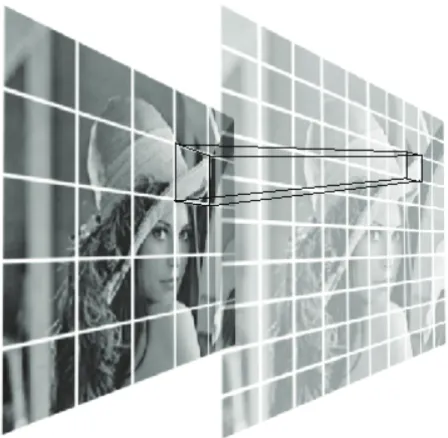
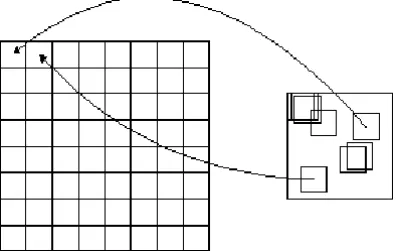
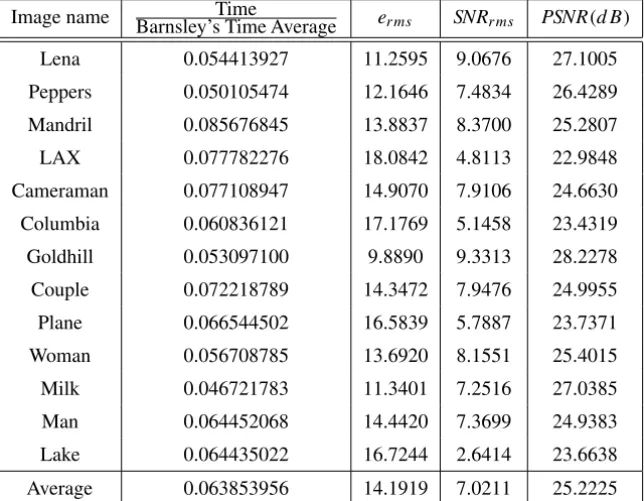
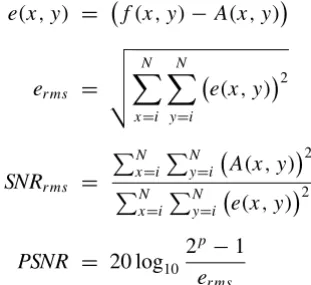



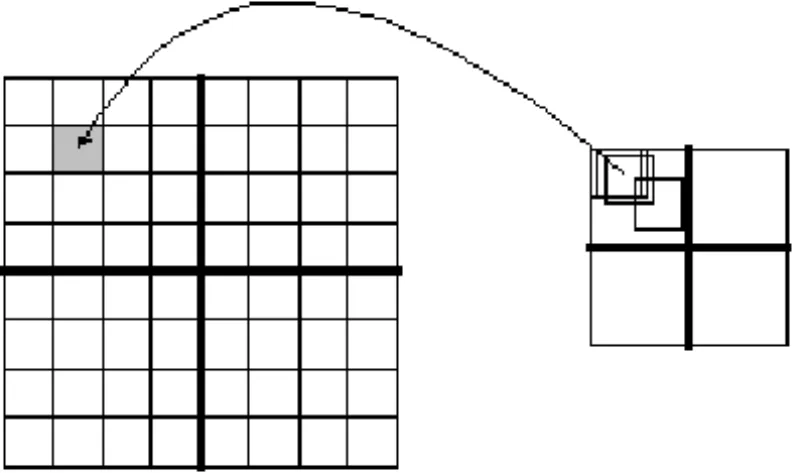
![Table 3 – Performance of the Restricted Area Search’s method [12] for the same images.](https://thumb-eu.123doks.com/thumbv2/123dok_br/18977810.455927/15.918.136.786.144.654/table-performance-restricted-area-search-s-method-images.webp)